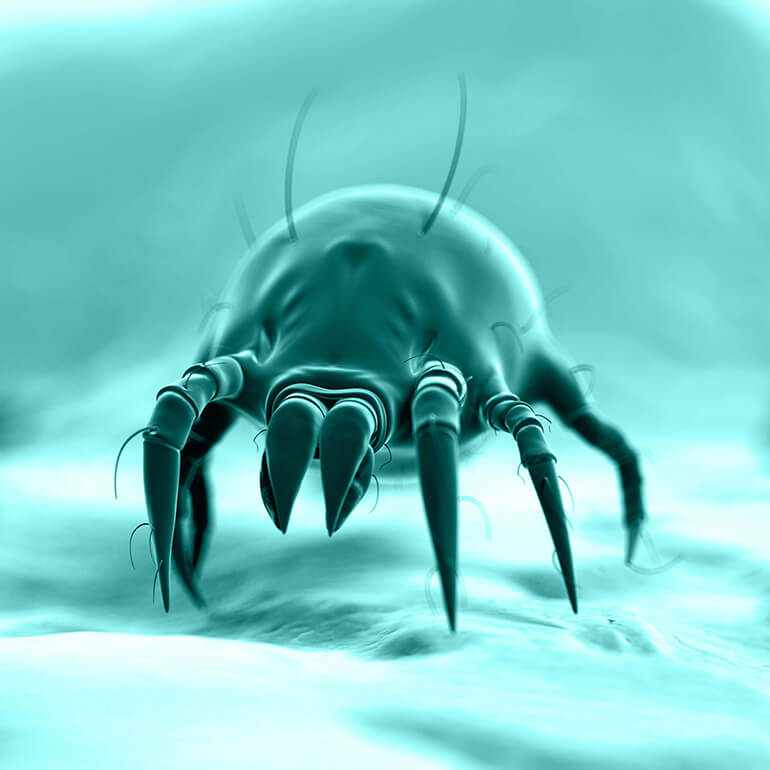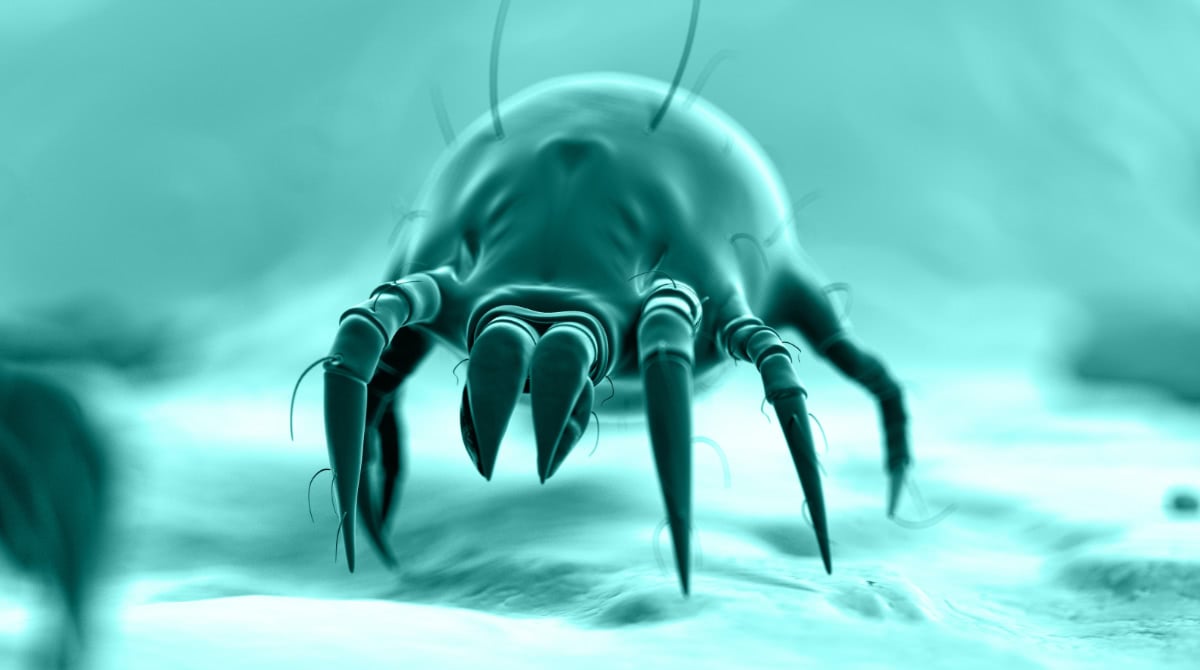Dust mites don't bite but they can cause other problems.
What’s the grossest bug you can think of? Cockroach? Nope. Centipede? Nope. Spider? Well yes, but there’s a different one that we’re thinking of: the dust mite.
What do dust mites look like? These things are ugly. They’re nasty and kind of look like something from out of a horror movie. They’re also everywhere, including your home, your carpet, your bed, and even your face.
Okay, we didn’t mean to scare you there. The dust mite may be everywhere, but it’s almost completely harmless and pretty normal to have around. The concern with dust mites doesn’t come from the bugs themselves. Dust mites cannot and do not bite. They are not parasites. The bugs themselves can’t do direct harm. The concern with these tiny little nasty looking things is the allergens they produce, resulting in dust mite allergies.
That’s why, in today’s blog post, we’re going to talk about how to help with a dust mite allergy, answer common questions like “Does baking soda kill dust mites?” and more. First off, what are dust mites?
What are dust mites and what do dust mites look like?

A dust mite is a microscopic pest that kind of looks like an insect but is technically not one. They look a lot like a teeny tiny cockroach, and they don’t have a face, which makes them more or less ugly depending on what you think of bug faces. You can’t see a dust mite with the naked eye, as adult ones are only about five micrometers long. That’s about the size of your average bacterium.
Dust mites feed primarily on gross stuff like dander and skin cells, thus are frequently found in places where that stuff builds up like mattresses, couches, and linens. As most homes have these things, the vast majority of houses would have a detectable dust mite presence if tested.
Dust mites can be tested for by collecting some dust and looking at it under a microscope.
Where do dust mites live?
As stated, dust mites love fabrics and places where dead skin cells collect. They’re big fans of dander and flakes of skin and prefer to eat that. Mattresses are often their go-to hideout as humans probably shed more skin cells there than anywhere else. Carpets, couches soft chairs, rugs, and curtains are also prime dust mite habitat.
Humidity is an essential factor in your home’s ability to house and breed dust mites. These creatures don’t drink water, but instead, absorb it from the air around them. Because of this, they can become dehydrated and die in environments where the humidity levels are too low.
Optimum conditions for growth and development are around 75-80 degrees F and 70-80 percent relative humidity. House dust mites absorb and lose moisture through their skin, and are very vulnerable to dehydration. Consequently, humidity levels within the home have a significant effect on survival. Dust mites cannot survive well at relative humidities below 50 percent. (Source: University of Kentucky Entomology Dept )
What are dust mite allergies?
Dust mite allergies are a little like pet allergies in the sense that it isn’t the creature itself that you are allergic to, but rather a protein that it releases. These proteins are released from the mites when they shed skin and expel waste.
These allergens build up on soft surfaces and can be sent in the air easily by the shaking out of sheets, lifting of couch cushions, or walking on carpets. Next thing you know, lots of allergens are populating your air.
Dust mite allergies also don’t have a particular season, so symptoms happen year round. This is unfortunate for the more than 25 million Americans who have asthma, as dust mite allergies are prevalent among asthmatics and are often identified as the root cause of its development.
Symptoms of dust mite allergies
- Sneezing
- Runny nose
- Itchy eyes
- Congestion
- Cough
- Can trigger an asthma attack
How do you treat dust mite allergies?
Want to know how to reduce a dust mite allergy? The most successful approach to treating dust mite allergies is to remove the things from your home that dust mites require to survive. This can be done with a couple of easy steps, which we’ll break down right here.
First, it’s essential to understand that you’re never getting rid of all dust mites. There is always going to be some dust mites lumbering about in your home. You can, however, significantly reduce the number of them and make your home much healthier with some simple and routine items.
Decrease the humidity
Humidity is a vital environmental element for dust mites. They need a high level of humidity to survive, so stripping them of that is an effective way to make your home environment non-conducive to dust mites.

A dehumidifier is the best way to do this. This home appliance does exactly what it sounds like: decrease the humidity. These devices work by pulling air into them like an air conditioner and then using a refrigerant to condense water vapor in the air into water droplets. The droplets then fall into a pan or reservoir that you empty when it's full. Quite simply, it pulls the water out of your air.
Dehumidifiers come in a variety of sizes and a range of prices. The smallest is the portable kind, which works well for individual rooms like a bathroom or closet, and they start at only around $20. Larger dehumidifiers that work for entire areas of your home will cost into the hundreds, and whole-house models even exist that cost four digits.
High humidity in the home contributes to the presence of more allergens than just dust mites. Molds and other fungi love humid environments. So a dehumidifier is an excellent way to tackle multiple different allergens and is how to help with a dust mite allergy.
If you live in a southeastern state, where the air is made of soup during the summer, congratulations. You’re more vulnerable to dust mites in your home than most other places.
Remove carpeting if possible.
Another effective way to make your home a less appealing environment for dust mites is to remove as many soft surfaces as possible. Soft surfaces, like carpets, are predisposed to dust mites because of how well they hold pollutants like dust and skin cells. Removing carpets altogether seems extreme, and it may be in many cases. However, if you have severe dust mite allergies, it may be necessary.
Hardwood floors will still accumulate allergens and allergy attractors like dust and skin cells on them. They’re much easier to clean though, and particles don’t get stuck inside them.
If you elect to stick with carpet, be sure to get low-pile carpet. It is easier to clean and has less capacity for holding dust and particles. High-pile carpeting is pretty much an allergy-sufferers worst nightmare, so stay away from that.
Vacuum and dust often.
Routine cleaning of the surfaces in your home is an absolute must for dust mite allergy sufferers. Allergens that dust mites produce can settle quickly into dust and get suspended in the air with the dust particles. Dusting with a damp cloth or paper towel will help collect these allergens with the dust particles. You should dust at least once a week.
Regardless of whether you have carpet or hardwood, include weekly vacuuming with your weekly dusting to remove allergens from your home. A vacuum designed to take on pet hair works well, as dander is often released with pet hair and is a primary attractor of dust mites. These vacuums typically come with a HEPA filter to trap small allergens like pet dander. A HEPA filter vacuum is critical for dust mite allergy sufferers because dust mite allergens are also quite small and could blow back into your home without said filter.
Wash mattresses and sheets even more often.
In addition to vacuuming and dusting your home’s surfaces, washing your bed sheets and covers at least once a week is an easy and effective countermeasure in the fight against dust mites. As mentioned above, mattresses and things on mattresses are spot number one for dust mites. You spend more time in your bed than any other place in your home, so naturally, this is where most of the dead skin will accumulate.
Humidity is naturally increased on your mattress because you perspire when you sleep, adding to the attractiveness of the mattress to the dust mite.
Wash your sheets, covers, and pillowcases at least once a week and make sure to wash in hot water. If hot water isn’t an option, you can opt for allergen-targeting laundry detergent. These detergents use an additive called ACARIL to specifically target allergens like dust mites and the things they eat.
It’s pretty important to clean your mattress regularly too, as washing your linens only tackles part of the problem. If you’re wondering “Does baking soda kill dust mites?” the answer is yes! Baking soda is a pretty potent weapon against dust mites in your bed. Using it is a simple process as well. Add a little bit of essential oil to the baking soda and then spread it across the top of your mattress, then vacuum. This is a proven way to help rid your mattress of a dust mite infestation.
Use of essential oils can help to kill the dust mites before the vacuuming begins.
Use at least a MERV 8 pleated air filter.
While Allergens produced by dust mites may not stay suspended in the air as long as other allergens, they can still enter the air very easily. Sitting down on a couch, falling onto your bed, or lifting your sheets to make your bed can send dust mite droppings and other allergenic mite products into the air you breathe. This creates a situation ripe for an allergic reaction.
If you’re using a low-quality air filter, it might not catch these allergens, which allows them to cycle back into your home and the air you breath. Using a pleated air filter of at least a MERV rating of 8 will help to eliminate dust mite allergens from your home that are floating in the air.
Take medication.
If you find that eliminating the environment for dust mites isn’t working as well as you’d like, over-the-counter allergy medications like antihistamines and decongestants can treat your symptoms. These are usually inexpensive and available at about any grocery store or general store.
Dust mites are pretty nasty, and the allergens they produce can be a real problem in your home. But now you know our proven tips for how to reduce a dust mite allergy. Luckily, with the right routine cleaning practices, you can make your home a much less appealing environment for these microscopic pests and a much more appealing environment for you and your family.
Topics:




